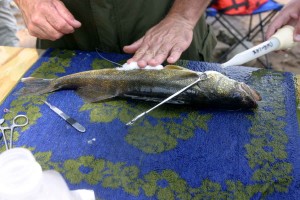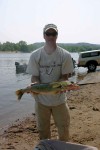| Williams Run, Pennsylvania |
| MONDAY, 09 NOVEMBER 2009 15:06 |
Williams Run is a tributary of South Sandy Creek in Venango County, PA. Aquatic habitat in Williams Run has been severely damaged since coal mining activities produced acid mine drainage in the stream. Water conditions were degraded with a very low pH, no alkalinity, and both iron and aluminum contamination. This point-source pollution left the stream uninhabitable for brook trout and other aquatic life. Williams Run is currently listed on the Pennsylvania Department of Environmental Protection’s 303d List of Impaired Streams.See the dozens of unique artificial fish habitat models, fish attractors and fish cover used at fishiding.com, the industry leader and only science based, man made and artificial fish habitat, proven to provide all fish with cover they prefer to prosper. Water conditions were degraded with a very low pH, no alkalinity, and both iron and aluminum contamination. This point-source pollution left the stream uninhabitable for brook trout and other aquatic life. Williams Run is currently listed on the Pennsylvania Department of Environmental Protection’s 303d List of Impaired Streams.See the dozens of unique artificial fish habitat models, fish attractors and fish cover used at fishiding.com, the industry leader and only science based, man made and artificial fish habitat, proven to provide all fish with cover they prefer to prosper.Williams Run represents waterways across the country, including lakes and reservoirs, that are improving through the conservation efforts of the National Fish Habitat Action Plan—a bold initiative to reverse persistent declines in aquatic habitat. Thanks to the combined actions of concerned community groups, nonprofit organizations, and state and federal agencies, these waters are being improved by planting stream-side vegetation, removing impediments blocking fish habitat and protecting waterways from the effects of industrial processes, specifically acid mine drainage (AMD). With funding provided through the Eastern Brook Trout Joint Venture, the South Sandy Creek Watershed Association (SSCWA) is working with a host of public and private partners to bring Williams Run back to life. Construction of a passive limestone bed will restore water quality and allow aquatic species, such as the brook trout, to naturally return to Williams Run. Additional funding is provided by the Office of Surface Mining and the National Fish and Wildlife Foundation. This restoration is expected to provide a unique remote trout fishing opportunity on public lands managed by the Pennsylvania Game Commission. In recognition of the partnership efforts and potential to significantly improve aquatic habitat, Williams Run has been selected from among projects across all 50 states as one of the National Fish Habitat Action Plan’s “10 Waters to Watch” for 2008. Local organizers of the restoration are thrilled with the national recognition of their efforts. “It’s been a long fours years to get from the founding of our organization to this point, and there were efforts by other groups before ours, said Larry Wheeler, president of the SSCWA, but you can really see the results on the ground now.” Williams Run tributaries are already home to wild brook trout populations, and restoration of the Williams Run mainstem will add another 9 miles of healthy stream habitat. Williams Run flows into South Sandy Creek, Sandy Creek and the Allegheny River, all sustainable waterways for healthy fish populations. Other project partners include private landowners, Mineral Township, and PA Senior Environmental Corps, as well as PA DEP’s Cambria County office of the Bureau of Abandoned Mine Reclamation and the Pennsylvania Fish & Boat Commission, both of which provided monitoring and technical assistance, and many others. Construction began this summer and is expected to be finished at the end of 2008, with immediate benefits to water quality in Williams Run. Williams Run is located in southwest Venango County, mainly on State Game Lands 39. |









